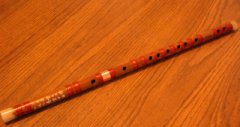I’m not even sure what category this should be filed under to be completely honest, but I was wondering if many of you have come across this new hybrid instrument called a “Futujara”?
It seems to be a development of the Fujara (the Slovakian shepherd’s fipple flute).
I seen it posted on YouTube about a couple of months back and just thought it sounded “mad”!
I’ll post a link to it for anyone who has never seen or heard it before:
http://ie.youtube.com/watch?v=1Vv9OHA1lPw
Well, that was something “different” for me anyhow.
On a completely different note, I had a few tunes with Cathal Mc Connell who was up in Derry yesterday, and he was showing me a couple of new flutes that he had.
One was made by a guy whose name escapes me just now (I think his Cathal said his surname was “Gallagher”, but I can’t remember 100% to be honest). Anyhow, the flute was made out of ‘dogwood’, which I thought was a very interesting choice of wood, and it almost felt as light as a bamboo flute. It was definitely very interesting.
The second one he showed me, I am guessing was oriental. I think it was Chinese, (I was told but can’t remember) so again don’t quote me on that. There was a massive length of extra wood beyond the tone/finger holes and the embouchure hole (like in some Japanese flutes I’ve seen), so instinctively, I was moving my head up to the top of the flute to find the embouchure hole, and Cathal kept having to direct my head down towards it, laughing while doing so, as I’m sure he must have been doing the same thing the first time. Now the thing about this flute was that it had SEVEN instead of SIX tone/finger holes, with the seventh tone hole covered being D. I’m trying to work out again what the fingering system was, as with one tone hole covered, you got B, 2 = A, 3=G, 4=F NATURAL, and from there on I’m not 100% sure.
I know that (as already said) that with 7 fingers down, you got D, and I’m almost sure that with 6 tone holes covered you were getting E, so I’m guessing that with 5 fingers down it was most likely F#?
It was very handy for doing rolls on F natural, but then it made it a bit harder to do E rolls with your wee finger (4th finger), as it’s obviously weaker and untrained, if you are used to rolling with your 6th finger for an E roll. Another thing, now that I remember, was that it had this hole between the embouchure hole and the first tone hole, and Cathal was telling me that the purpose of this was that it was usually covered with rice paper? But he said he didn’t really bother with that and I think he just had it taped over.
I think it would be too frustrating for me to try and get my head around it, but Cathal really liked it, and was getting some nice sounds out of it.
Sin é,
Murrough
